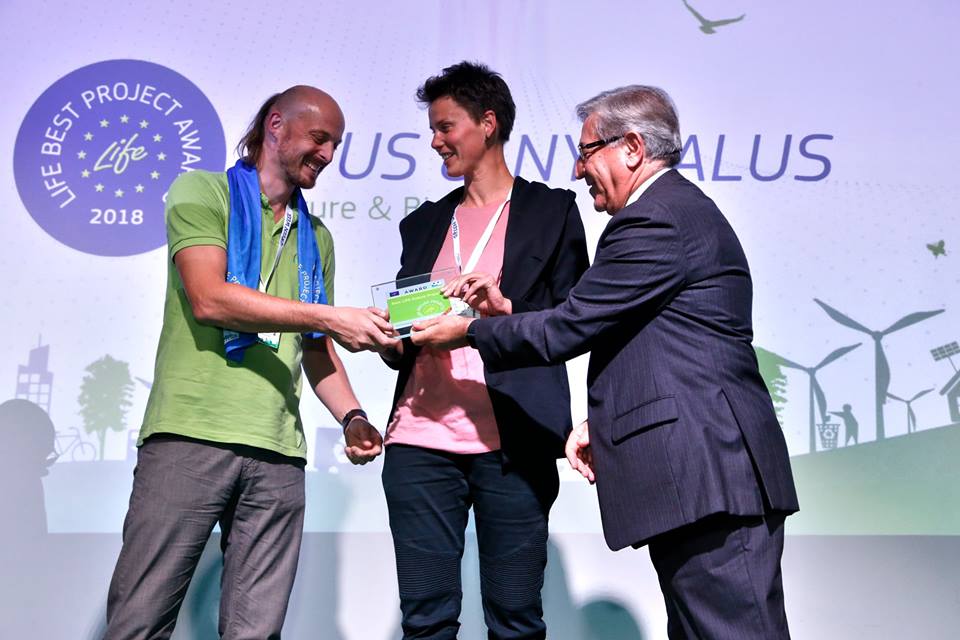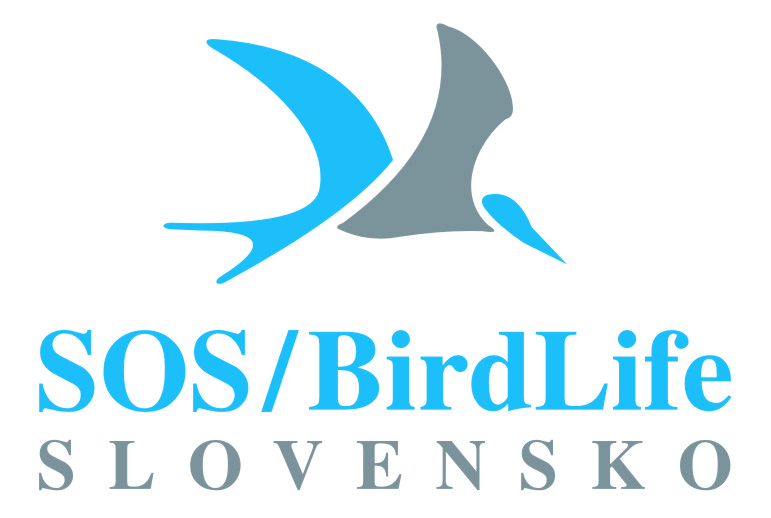We implement internationally awarded projects
Common Swift (Apus apus) and some of the bats, in particular Common Noctule (Nyctalus noctula) have been considered as the common species in Slovakia. Since they lost many natural habitats (e.g. old forest stands with large tall trees with suitable tree-hollows) and thanks to creation of appropriate artificial breeding opportunities in human settlements, gradual shift of roosting strategy of swifts and bats was recorded. During the last decades they moved into the urban sites where they occupy mainly prefabricated panel houses. At the present nearly 100% of the Slovak swift population breeds in man-made structures, e.g. various gaps, ventilation shafts, cracks, attic roofs. Recently the greatest threat to the siwfts and noctules is reconstruction and thermal insulation of buildings which are occupied by swifts and bats. According to the most recent estimates the country population of swifts has dropped by at least 50-60% over the last decades.
- LIFE Best of the Best Award 2018
- CEEWeb Award on Excellence
- Main information
- Target species
- Main issues
- Project Objectives
- Activities and Results
- Photogallery
- How can you help?
- Film: Return of the swifts
Brusel, 24.5. 2018
The European environment comissioner Karmenu Vella awarded the best projects of the LIFE+ programme on 23rd of May in Brussels.
The BROZ project, in partnership with SOS (Birdlife Slovakia) and SON, that focused on protecting nesting habitats of common swifts and bats in buildings in Slovakia was awarded as one of the three Best of the best projects in the Nature and Biodivesity category.
The projects were awarded in of three categories – The Environment, Nature and Biodiversity and Climate. Out of the 420 projects supported by the programme across the EU, 62 were selected as the best projects EU projects. Overall BROZ had three projects awarded, two projects awarded as the Best ptojects and one awarded as the Best of the best.
The project for the protection of swifts and bats in buildings in Slovakia was realized between 2012-2016 during which the urban nesting opportunities of these species were enhanced by installing over 10 000 nesting boxes and saving over 15 000 nesting opportunities.
Read more:
Projekt ochrany prírody na Slovensku získal európsky titul Najlepší z najlepších
Najlepší z najlepších. Projekt ochrany dážďovníkov a netopierov zabodoval v Európe
Projekt ochrany prírody získal európsky titul Najlepší z najlepších

Project LIFE Protection of Common Swift (Apus apus) and bats in cities in Slovakia was awarded the CEEweb Award on excellence in biodiversity protection for it´s significant contribution to biodiversity protection in Europe.
Project title: Protection of Common Swift (Apus apus) and bats in buildings in Slovakia
Project scheme: LIFE+ Biodiversity
Acronym: Apus & Nyctalus SK
Project code: LIFE10 NAT/SK/000079
Coordinating beneficiary: Regional Association for Nature Conservation and Sustainable Development – BROZ (www.broz.sk)
Associated beneficiaries:
Slovak Ornithological Society / BirdLife Slovakia (www.vtaky.sk)

Slovak Bat Conservation Society – SON (www.netopiere.sk)

Implementation period: 01/01/2012 – 31/12/2015
Project budget: 1 481 248 € (50% provided by EC)
You can read more about the project on the project website
Non-governmental organizations and experts in Slovakia have been stressing negative impact of thermal insulation of prefabs on populations of birds and bats for several years. One of the most threatened species by these activities is Common Swift. Swifts have adapted to nesting in buildings due to the loss of their natural nesting habitats (e.g. hollow trees, rocks). Recently almost 100% of the population of Common Swift in Slovakia is nesting in buildings in cities and especially prefabs provide suitable nesting sites not-easily accessible by predators. Thermal insulation of prefabs has become an intensive and popular technology in Slovakia, particularly concerning old houses built back in 1960s and 1970s. Unfortunately this technology is applies especially during the most sensitive reproduction period of Swifts. In several cities it has led to a rapid decreasing of populations of Swifts or even to their complete disappearance from the cities.
Swifts’ nests can be found usually in ventilation holes or crevices between panels on prefabricated houses. In the same places and also in small hollow spaces under roofs colonies of bats can be found as well. Thermal insulation and reconstruction works often result in destruction of these nesting and roosting sites and trapping and killing of birds and bats inside buildings. The most critical period of the year is between April and August when the Swifts are taking care of their eggs, hatchlings and young birds. Swifts are strongly bound to their nesting sites. If these are destroyed for the birds it is a problem to find a new suitable nesting site.
It needs to be understood that Swifts and bats do have their role in urban ecosystems and are important for keeping ecological balance. They feed mainly on mosquitoes; one Swift can catch 50 grams of mosquitoes and one bat can catch over 3000 mosquitoes just during a one night.
Common Swift and all bat species occurring in Slovakia are listed as protected. Economic value of one individual of Swift is 165 EUR, economic value of one individual of bat varies between 165 EUR and 330 EUR, depending on the species. By entering the European Union Slovakia has committed itself to ensure appropriate protection of all species of the European importance, including birds and bats. If this commitment is not fulfilled there is a risk of high financial penalties to be paid by Slovakia to the European Union. If this happens it will be all of us to contribute via taxes.
Professional conservationists as well as public have been critical about bad timing and technologies applied during reconstruction of buildings. There are several species-friendly techniques implemented in other European countries that can be easily transferred and applied in Slovakia. Positive results of cooperation between ecologists and engineers and architects – e.g. timing-adjustment of construction, displacement of bat colonies from prefabs, preserving of existing nesting/roosting sites, installation of special boxes for Swifts and bats, can be observed already in several cities in Slovakia.
Since 2011 three NGOs – BROZ, SOS/BirdLife Slovakia and Slovak Bat Conservation Society (SON) have joined their forces to protect Swifts and bats in cities in Slovakia. One of the results is a joint project Protection of Common Swift (Apus apus) and bats in buildings in Slovakiaintroduced to you via this website. Within the project several actions have been implemented, including monitoring of populations of Swifts and bats in all cities in the country. Data are stored and processed in an on-line database available for experts and public, including construction companies, architects, and decision makers. The project is financially supported by the European Commission through the LIFE+ programme and by the Ministry of Environment of the Slovak Republic.
Public is invited to participate in the project’s implementation through providing data about occurrence of bats and birds in buildings or information about planning and/or ongoing reconstruction of buildings. Any information that seems to be unimportant can help us to save the species.
Project objectives:
The main project objective is to halt the recent decline of the Common Swift (Apus apus) and Common Noctule (Nyctalus noctula) populations in Slovakia due to the insulation and reconstruction of buildings in human settlements and to enhance their local populations through the protection of their nesting and roosting habitats especially in urban areas, introduction of suitable management and reaching the favourable conservation status of the species.
Project specific objectives:
– establishment and further strengthening of institutional conditions to enable systematic solutions for protection of nesting habitats of Common Swift and bats during reconstructions and insulations of buildings through training and improved communication with the key stakeholders (decision makers, state authorities, owners, users and janitors of buildings, architects, construction companies, etc.);
– protection of existing nesting and roosting opportunities and creation of new opportunities, including installation of special boxes for swifts and bats;
– awareness raising on the protection of Common Swift and bats and particularly of their nesting and roosting habitats in ruban areas.
PROJECT ACTIVITIES
A.1 Methodology for protection of Common Swift, bats and other species during reconstruction and insulation of buildings
The Methodology includes methods and technical measures that can be applied within the project conservation actions. It is focused on protection of bats, swifts and other bird species that occur in buildings (e.g. kesterl, swallow, house martin). The methodology is used mainly by the project staff and professional conservationists from the State Nature Conservancy of the Slovak Republik as internal material. It is regularly updated and will serve as a basis for elaboration of the guideline and detailed manual for public. To download the Methodology click HERE (.PDF format; 30 MB; in Slovak).
A.2 Monitoring of Common Swift in urban areas in Slovakia
Monitoring is implemented in the whole territory of Slovakia, particularly in cities. Detailed monitoring is carried out in all 8 regional capitals (Bratislava, Trnava, Trenčín, Nitra, Banská Bystrica, Prešov, and Košice) as well as in other 40 selected district cities. It is carried out every year in a period between the 20th of April and 10th of August by applying an identicak methodology in order to collect comparable data.
Results: In 2012-2015 more than 19,100 buildings in 270 cities were checked to get data on occurrence of protected birds and bats. In total 6,639 nesting sites of Common Swift were recorded on buildings. Another nesting sites were observed in roofs of sacral buildings, mainly churches. Number of nesting Swifts pairs observed during the monitoring varied between 23,547 and 23,697. Data are gathered and processed in the on-line database AVES Symfony (http://aves.vtaky.sk/apusbat) available to public. Recently there is 10,800+ records on presence of birds and bats in buildings.
Conservation measures were applied in 1,600+ cases of reconstructed or thermally insulated buildings. On these sites in total 42,853 potential nesting sites of Swift were recorded, out of which 11,018 were occupied by birds. Through installation of modified plastic grids and nesting boxes in total 30,915 nesting sites were preserved and created. It can be concluded that the project succeeded in preserving and even increasing number of nesting sites despite an ongoing reconstruction of buildings in Slovakia.
In 2014 a monitoring of occupancy of Swift boxes on selected 28 sites was launched. In 2014 in total 104 nesting sites occupied by birds (including 74 sites with nesting Swifts) were recorded. In 2015 it was 177 nesting sites occupied by birds, out of which 121 nesting sites were occupied by Swifts. The occupancy has increased by 70.19% comparing to the observation in 2014. Number of nesting pairs of Swift has increased by 63.15%.
Concrete conservation actions positively affected ca 50% of the Swifts population in Slovakia. If they are not implemented it is assumed that 30-50% of nesting sites would be destroyed and the Swift population would decline by 20-30%.
Outcomes: Methodology for monitoring of Common Swift in urban areas in Slovakia (in Slovak; download HERE); Report from monitoring of Common Swift in urban areas in Slovakia in 2012 (in Slovak; download HERE); Report from monitoring of Common Swift in urban areas in Slovakia in 2013 (in Slovak; download HERE); Report from monitoring of Common Swift in urban areas in Slovakia in 2014 (in Slovak; download HERE); Report from monitoring of Common Swift in urban areas in Slovakia in 2015 (in Slovak; download HERE); Report from monitoring of occupancy of Swift nesting boxes in 2014-2015 (in Slovak; download HERE).
A.3 Education and training of key stakeholders and decision makers
The project’s key stakeholders (state authorities, owners and janitors of buildings, architects, building companies, etc.) are informed about appropriate measures to protect swifts and bats during thermal insulation and reconstruction of buildings as well as with specific technical measures to preserve nesting and roosting sites, including installation of special boxes for the species. Workshops and trainings are organized for the stakeholders in all regional capitals (it is foreseen that in total 32 trainings will be organized during the project lifetime).
Results: In 2012-2015 in total 15 workshops for more than 345 stakeholders were organized in the following cities: Banská Bystrica, Bratislava, Jelšava, Košice, Prešov, Žilina, Nitra, and Trenčín.
A.4 Monitoring of Common Noctule in urban areas in Slovakia
Population of Common Noctule is monitored in all 8 regional capitals (Bratislava, Trnava, Trenčín, Nitra, Banská Bystrica, Žilina, Prešov, and Košice). Identical methodology is applied during the monitoring in order to gather comparable data.
Results: In 2012-2015 more than 19,100 buildings in 270 cities were checked to get data on occurrence of protected birds and bats. In total 1,800 rosting sites of Common Noctule and other bat species, mainly pippistrelles were recorded. The highest density of roosting sites per sqyare kilometer was recorded in Prešov, Trnava, and Trenčín. In addition to that another 160+ buildings, particularly roof of sacral and historical buildings, were checked and 60roosting sites of bats recorded. Numerous colony of Greater Mouse-eared Bat with more than 2400 individuals was found in a roof of an art school in Dolný Kubín. In close cooperation with the City conservation measures to preserve the roosting site and the colony are recently implemented. Also within this action monitoring of bats roosting in boxes on selected sites is carried out.
During the monitoring of occupancy of bat boxes in total 526 boxes were checked for presence of bats. In 2015 in total 53% of the boxes were occupied by bats which is a great result taking into account only 2-year-short period.
In order to gather more information on ecology of Common Noctule special monitoring with car-data-loggers was carried out in 2014 and 2015. This is a specific methodology that requires sufficient expertise and specific equipment. The total length of transects reached 1,040 km. Common Noctule bat was recorded on 90% of the transects in 2014 and on 98% in 2015. Sound records of Common Noctule bat represented 42% out of all records in 2015.
In 2014-2015 monitoring of summer breeding colonies of bats was implemented on 318 localities in Slovakia. In total 85,500 individuals of 9 species of bats were observed during the monitoring.
Outcomes: Methodology for monitoring of bats in urban areas (download HERE) and Field sheet (download HERE) (both in Slovak); Report from monitoring of Common Noctule and other bat species in urban areas in Slovakia in 2012-2013 (in Slovak; download HERE); Report from monitoring of Common Noctule and other bat species in urban areas in Slovakia in 2013-2014 (in Slovak; download HERE); Report from monitoring of Common Noctule and other bat species in urban areas in Slovakia in 2014-2015 (in Slovak; download HERE); Report from monitoring of Common Noctule and other bat species in urban areas in Slovakia in 2015-2016 (in Slovak; download HERE); Report from monitoring of flying activity and summer breeding colonies of bats in 2013-2015 (in Slovak; download HERE).
A.5 Guideline for protection of birds and bats during insulation and reconstruction works in buildings
Guideline is elaborated in cooperation with the Ministry of Environment of the Slovak Republic and will include also concrete recommendations and detailed description of the most appropriate conservation measures. The guideline will be finalized and distributed before the end of the project.
Results: “General principles on protection of species in buidlings” was elaborated and the project’s staff trained on its implementation. Based on the field experience gained during 2012 an analysis on implementation of the principles was elaborated and submitted to the Ministry of Environment. Main weaknesses shown in the analysis are: (i) insufficient legal competencies of environmental offices towards construction offices; (ii) lack of information about technical conservation measures; and (iii) insufficient personal capacity to oversee application of the conservation measures. In 2014 an updated guideline was elaborated and submitted to the state authority. It is expcted that the state authority will organize an official meeting with all relevant partners, including governmental as well as non-governmental institutions.
Outcomes: General principles on protection of species in buildings – updated version (in Slovak; download HERE).
C.1 Practical conservation measures for protection of swifts and other bird species during reconstruction and insulation of buildings
In cooperation with state authorities, owners and janitors of buildings, architects and building companies concrete conservation measures to preserve existing nesting sites and create new sites are applied on at least 40 model localities during the project implementation. One of the most often applied measures is installation of modified plastic grids on ventilation shafts that will enable birds to enter their traditional nesting sites also after the reconstruction and insulation of building is finished.
Results: Model conservation measures for Swifts and other birds were implemented on 120+ sites in Slovakia. In addition to that “combined” measures focused on both birds and bats were implemented on 416 sites. The most often implemented measure is installation of modified plastic grids on ventilation holes in attics (14,400 grids on 400+ sites) as a simple and cost-effective solution. Other model measures include creation of nesting holes in reconstructed walls of the Vígľaš castle, adjusted timing of construction works to allow birds nesting, installation of special types of Swift boxes, etc. The project’s staff elaborated 800+ expertise on protection of birds and bats in buildings. In cooperation with external experts a Catalogue of model solutions was elaborated. The Catalogue is an internal document and is addressed to the project’s staff and personel.
Outcomes: Catalogue of model solutions (in Slovak; download HERE)
C.2 Installation of nesting boxes for swifts
Special nesting boxes for swifts are installed on buildings that are being reconstructed and traditional nesting sites cannot be preserved. The boxes are installed also in localities from where the swift populations have disappeared due to the reconstruction and insulation of buildings in order to restore the local populations. At least 1200 nesting boxes for swifts will be installed in the frame of the project.
Results: During the project in total 2,400 special nesting boxes for swifts were installed on buildings and other constructions (e.g. chimneys) with financial support from the project. Through this action 7,000+ new nesting opportunities for swifts and other birds were created. In Revúca, Košice, and Trebišov nesting walls for swifts were created. Within the project we succeded in increasing the number of nesting sites on 417 localities in Slovakia. In total 12,739 nesting sites were recorded in 2015, comparing to 6,083 nesting sites recorded at the beginning of the project in 2012..
At the end of 2015 we launched a successful public-funding StartLab campaign to collect money for erection of the very first Swift tower in Slovakia. The tower will be erected in April 2016 in Bratislava.
C.3 Practical conservation measures for protection of bats during reconstruction and insulation of buildings
Free of charge consultations and assistance on conservation measures is provided to building companies that are dealing with reconstruction and insulation of buildings. The project staff communicate with the key stakeholders to pursue them to preserve traditional roosting sites of bats in buildings. At least 400 special boxes for bats will be installed during the project implementation.
Results: Model technical measures were applied on more than 650 sites. Mainly the following measures were implemented: displacement of bats from buidlings, saving bats trapped in closed-up plces, removing of guano, etc..
In total 800special boxes for bats were installed on buildings and other constructions (e.g. chimneys, bridge) with financial support from the project. It was observed that in average 76% of the boxes were occupied by bats in 2015.
Actions on protection of summer breeding colonies of bats in roofs of sacral and historical buildings were implemented, including cleaning guano and protection of roof timbers and constructions from a negative impact of guano.
D.1 Promotional materials and project’s presentation in media
Several promotional and information materials will be elaborated for the public, including the project’s web site, film, papers and presentations via internet, radio and TV, also stickers, leaflets, posters, brochures, technical manual, exhibition “Return of Swifts” and Layman’s report.
Results: The following promotional and informational materials were developed in the project’s framework:
– leaflets With bats under one roof and Common Swift (both in Slovak) (73,000 pcs); stickers with motif of Common Swift (28,000 pcs); pocket calendars with motif of Common Swift and Common Noctule (250 pcs); poster (4,500 pcs); booklet (3,450 pcs); technical manual (2,000 pcs); film on DVD (1,200 pcs); Layman’s Report (1,000 pcs).
Film Return of Swifts (30 min) is about Swifts and bats in cities and their protection. It is in Slovak with English subtitles. The first public presentation of the film took place during the conference in Žilina. Film will be presented at the festival EKOTOPFILM 2016 and on a commercial TV. Film is available upon request; please contact BROZ.
In total 4 press conferences were organized within the project. The project’s actions and results were presented through 147 media outcomes, including printed and internet media, TV and radio. Official project’s website was created and is regularly updated. Information about the project can be found on Facebook as well.
In 2014 exhibition “Return of Swifts” (5 roll-ups and a model of a panel house with nesting and roosting sites and technical measures to protect them) was developed. The exhibition was presented at several venues and events, e.g. premises of the Ministry of Environment of the Slovak Republic, ornithological conference in Zvolen (100+ participants from Slovakia) and EUROBATS meeting in Brussels (100+ participants from 44 countries).
Outcomes: Manual on protection of birds and bats during reconstruction and insulation of buildings (in Slovak; download HERE); Facebook https://www.facebook.com/navratdazdovnikov.; Common Swift – leaflet (in Slovak; download HERE), With bats under one roof – leaflet (in Slovak; download HERE); Return of Swifts – exhibition panels (in Slovak; download HERE); Poster Protection of birds and bats in buildings (in Slovak; download HERE); Booklet Protection of Swifts and Bats in urban areas (in Slovak; download HERE); installation of notice boards – an example (download HERE); Layman’s Report (in English; download HERE|.
D.2 Meetings with key stakeholders
We meet with the key stakeholders on a daily basis and communicate with them conservation measures for protection of swifts and bats in buildings. An effort is put in gaining their support to the application of the measures. They are informed about alternative solutions that can be applied instead of traditional technics that do not support protection of the species and their habitats.
Results: More than 4,160 informal personal meetings with stakeholders (buildings and construction companies, owners, decision makers, etc.) were organized in 2012-2015 to discuss available protection measures for birds and bats. The project’s staff communicates and cooperates also with professional conservationists from the State nature Conservancy of SR, with representatives of Bishop Conference of Slovakia (protection of summer colonies of bats in churches) and with experts-scientists from universities.
D.3 Excursions in cities and presentations at schools
Presentations and excursions are focused particularly on school kids, students and their teachers to strengthen their emotional relationship to the environment. These target groups are expected to forward the information further within their communities.
Results: In 2012-2015 in total 312 lectures and excurions to the project’s sites were organized for more than 3,000 participants, mainly children and students. In close cooperation with State Forests of Tatra National Park educational materials about bats and their ecology and protection were elaborated for elementary schools.
D.4 Workshops, national and international meetings for experts and stakeholders
Workshops and meetings for experts and stakeholders are organised in order to share information, experience and to create personal contacts among experts dealing with species protection in buildings.
Results: In 2012 and 2013 in total 2 national workshops in Zvolen and Slatinka (57 partcipants) and 8 regional meetings in Bratislava, Košice, Zvolen, Nitra, Považská Bystrica, and Ďurčiná (102 participants) were organized within the project. Besides presentations of project’s actions the participants were trained on using of bat scanners for bats monitoring. In 2012 the 1st international conference focused on protection of birds and bats during insulation and reconstruction of buildings was held in Zvolen. The conference was the first of its kind held in the regiona of South-Eastern Europe and was attended by 120 experts from Slovakia and other European countries, e.g. U.K., Spain, Poland, Czech Republic, Ukraine. In 2014 preliminary results of the project were presented at international conference on ecology and protection of swifts held in Cambridge (U.K.). It was attended by 110+ participants from around the world. In October 2014 the project was presented at Academy on Green Infrastructure held in Rackeve (Hungary). The Academy was organized by CEEweb for Biodiversity and was attended by 70+ representatives of different institutions from Europe, including the European Commission. At the national level the project’s resulst were presented at ornithological conference in Zvolen and scientific conference “Zoology 2014” in Prešov. In 2015 the 2nd international conference took place in Žilina and was attended by 80+ experts from Slovakia and Czech Republic to discuss the project’s results and further cooperation.
E.4 Networking with other projects
Contacts with colleagues that are implementing projects with similar topics in other European countries are established and maintained. We share and exchange information on practical conservation measures for protection of swifts and bats as well as other related topics.
Results: In total 9 study tours to Germany, Spain, Poland, Czech Republic, Slovakia, Hungary, U.K. were organized during the project’s implementation. We have established contacts and cooperation with 12 similar projects and activities carried out in Europe and Israel. The project and its preliminary outcomes were presented at EUROBATS meetings in Bulgaria, Ireland and Belgium and at several conferencies in Slovakia and abroad.
The project significantly contributed into adoption of the EUROBATS Resolution 7.11 Bats and Building Insulation. The Resolution was adopted by 36 EUROBATS party states and calls upon Parties and non-party Range States to work to resolve any possible conflict between insulation regulations and bat conservation, include the impact on bats in the environmental assessment of insulation programs, recommend appropriate awareness-raising campaign and trainings for stakeholders, etc.
In December 2014 the project was awarded the CEEweb for Biodiversity Award for excellence in biodiversity protection (download the case study in English) in the category “Connecting and Restoring habitats and greening up urban spaces”. Through this award and related information campaign the project and its results has reached approximately 100 000 people in the EU member as well as non-member states, including representatives of EC abd international organizations such as IUCN, WWF, ECNC, EHF, etc.
Audit
An independent external auditor verified the project’s financial statements and reports by using standard auditing methods in accordance with the national legislation and LIFE+ Common Provisions and other requirements of the European Commission.
After-LIFE Communication Plan
After-LIFE Communication Plan will set out how the project’s results will be disseminated and communicated after the end of the project lifetime. The Plan will be elaborated along with the project’s final report.
Outcomes: After-LIFE Communication Plan (in English; download HERE).
PROJECT REPORTS
Inception report (in English) – download HERE (PDF format)
Mid-term report (in English) – download HERE (PDF format)
Progress report I (in English) – download HERE (PDF format)
Final Report (in English) – download HERE (PDF format)
Monitoring is a crucial part of species protection – Help us monitor Swifts and bats!
Database for monitoring swifts and bats in cities:
Thank you for your cooperation!
Team BROZ, SOS/BirdLife Slovensko a SON




